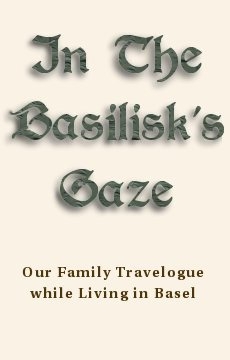Finding a Home
 Friday, March 20, 2009 at 1:47PM
Friday, March 20, 2009 at 1:47PM The Stegreif Mill is in a lovely area: as well as the peaceful canals of the St-Alban Teich that run amongst the traditionally decorated buildings, there is a preserved section of the old city wall and the
St-Alban Tor, an original city gate, visible on the hill from almost everywhere nearby.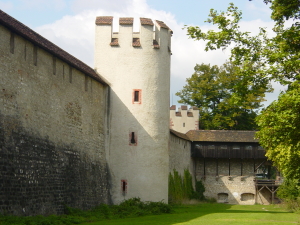 And one of the Rhine ferries crosses the river near the mill. The ferries are strung from pulleys on a cable over the river, and operate entirely by hydro-power. The ferry pilots simply adjust their rudders so that the flow of water past the boat pushes it across the river. Overall, it was a charming quarter, if a little sedate.
And one of the Rhine ferries crosses the river near the mill. The ferries are strung from pulleys on a cable over the river, and operate entirely by hydro-power. The ferry pilots simply adjust their rudders so that the flow of water past the boat pushes it across the river. Overall, it was a charming quarter, if a little sedate.
There were some downsides to living in an old museum building, however. The first of these materialised each Friday and Saturday night, as a series of screeching, creaking noises that seemed to emanate from above us, and went on until around 1 o’clock in the morning. Marion’s first theory was that someone was moving furniture upstairs. When it continued, Mark decided someone might be demonstrating some old piece of machinery in a display room up there, but it seemed too relentless even for that. 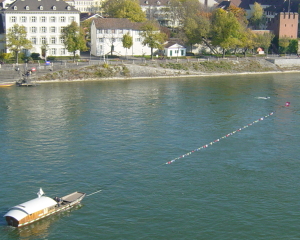 It took several weeks before we hit upon the correct explanation: dinner guests were moving their chairs on the stone floor of the restaurant below us and the sound was being transmitted by the walls of the building into the beams of our apartment. On other nights of the week, the restaurant was quieter and so people were more careful when getting up and down. We eventually grew accustomed to falling asleep to the accompaniment of squeaks and scrapes.
It took several weeks before we hit upon the correct explanation: dinner guests were moving their chairs on the stone floor of the restaurant below us and the sound was being transmitted by the walls of the building into the beams of our apartment. On other nights of the week, the restaurant was quieter and so people were more careful when getting up and down. We eventually grew accustomed to falling asleep to the accompaniment of squeaks and scrapes.
Another issue was privacy. Our kitchen and living room windows looked, not only over the water wheel, but also directly into the printing machine exhibit room on the second floor of the Gallician Mill. Museum visitors often paused to watch us having lunch, only a few metres away. Of course, having seen those visitors pulling levers and operating other impenetrable machinery, we couldn’t resist visiting the museum ourselves.
As advertised, visitors can make their own paper there. 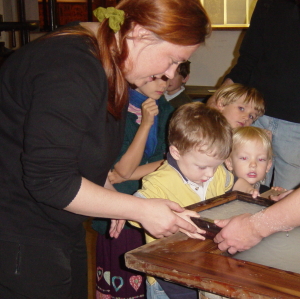 On the ground floor, the water wheel drives a crude cam that lifts and drops three meter long wooden hammers. The crashing noise dominates the space, as old strips of linen are smashed into a fine pulp, suspended in water. The suspension can then be deposited onto filters by hand, creating a thin layer that dries into paper. Visitors are invited to perform the filtration step, and it turned out that even a three year-old can manage it.
On the ground floor, the water wheel drives a crude cam that lifts and drops three meter long wooden hammers. The crashing noise dominates the space, as old strips of linen are smashed into a fine pulp, suspended in water. The suspension can then be deposited onto filters by hand, creating a thin layer that dries into paper. Visitors are invited to perform the filtration step, and it turned out that even a three year-old can manage it.
The rest of the museum is devoted to all aspects of printing — casting of type, printing presses, linotype machines, and even a somewhat poky display on the history of writing systems. The best bits are those directly connected to activites historically performed in Basel, which are well worth the entrance price.
Less than three weeks after we arrived, the boys turned three. Their grandparents came down to celebrate, bringing some especially appreciated birthday presents: a drill and a circular saw. 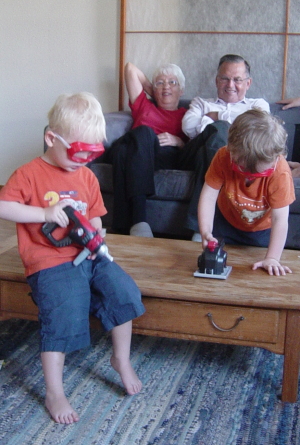 These kept our would-be tradesmen busy for hours.
These kept our would-be tradesmen busy for hours.
Meanwhile, we were spending our days viewing potential permanent apartments. Most rental contracts in Switzerland have a three month notice period from both sides. This means that good apartments are often advertised three months before they become available. To make matters worse, it is conventional for all Swiss rental contracts to begin and end on the first and last day of the month respectively. When we pointed out to one agent that this meant movers had nowhere to stay on the last night of the month, she replied “Yes, that can be a problem”. We remain flummoxed by this apparent collective stupidity. Either you pay double rent for a whole month, or compete with everyone else who is moving that month for transport services such as removalists and rental trucks on the first day of the month, and find somewhere to store all your goods for a single night on the last. It seems informal work-arounds are commonly agreed between tenants and landlords, but the official rules are rather impractical.
We looked at a handful of underwhelming apartments that were empty and available immediately. Some of them had been vacant for months, and one even had graffiti on its street face. It seems Swiss landlords have a fixed rent in mind, and if no-one is willing to pay that amount, they simply wait. The idea of lowering the rent to bring it into line with demand apparently never occurs to them.
On the road to despair, we finally found an apartment that had every feature on our original wish list; it was a spacious, light apartment overlooking the Rhine river in the more lively area of Kleinbasel (the part of Basel on the north-east side of the river). But the previous tenants were still there, and would be until December 1st, almost three months later. Worse, the landlord wanted to repaint the walls and repolish the floors, which would take more time. And it is also not customary to begin a rental contract on January 1st (for reasons we can only guess at), so it looked like we would have to spend more than four months in temporary accommodation.
Luckily, the landlord agreed not to renovate and we signed up for a December 1st start. The landlord of our temporary apartment also agreed to extend our lease until then. So while the wait would be longer than we had hoped, at least we knew where we would be living in Basel.
